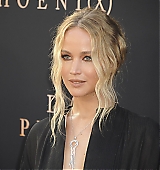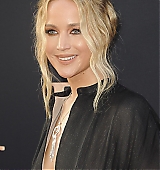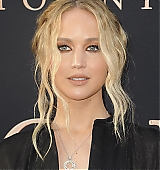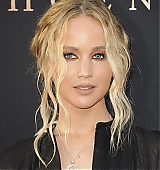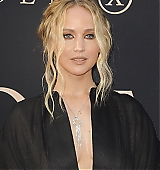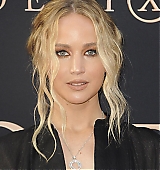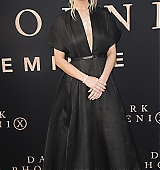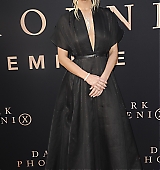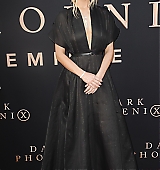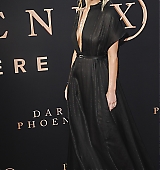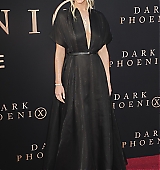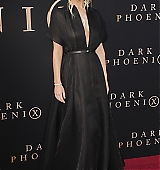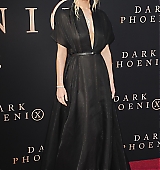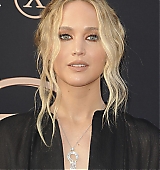I just updated the gallery with scans of Jennifer in 2011. This includes the latest issue of EW (thanks to Kari). I also capped the interview Jen did for The Hollywood Reporter:
Gallery Links:
- [x007] Scans in 2011 – January 26th: The Hollywood Reporter
- [x001] Scans in 2011 – February: W Magazine
- [x003] Scans in 2011 – February 4th: Entertainment Weekly
- [x066] Online Interviews – 2011 January: The Hollywood Reporter
And also here is the interview for THR:
Jennifer Lawrence: The Making of an ‘It’ Actress
The new Hollywood Reporter looks at the actress, once passed over for Bella in “Twilight,” and the year she’s had since becoming a Sundance sensation for “Winter’s Bone.”
Jennifer Lawrence cried when Winter’s Bone was accepted into the 2010 Sundance Film Festival. The picture, set in the Ozark Mountains, might have been tiny, but the actress had recognized that the part of Ree Dolly — a teen struggling to hold her family together and keep their home — was a gritty, uniquely tenacious role. So she pursued it with unabashed commitment, even taking a spontaneous red-eye flight to New York to press the producers for the part. At the time, her highest-profile role had been in Guillermo Arriaga’s stark low-budget drama The Burning Plain, which had just scored her the Marcello Mastroianni Award at the 2008 Venice Film Festival. Lawrence expected maybe a dozen people would see Bone, so its selection by Sundance was a splendid bonus for the cast, crew and co-writer/director Debra Granik. It was only a few days after its first screening that she realized that perhaps she had underestimated its impact.
“I got recognized on the street, and someone said, ‘I loved Winter’s Bone,’ ” the 20-year-old actress recalls. “And I was like, ‘You saw Winter’s Bone?’ ”
By now, Lawrence no longer is asking that question. The winner of the Dramatic Grand Jury prize at Sundance, Bone became a genuine indie hit after Roadside Attractions released it in June, grossing more than $6 million domestically. Lawrence herself was propelled into the awards melee: She was nominated for best female lead at February’s Spirit Awards, and was a Golden Globe nominee, which signals the likelihood that her name also will be among the Oscar noms announced Jan. 25 (right in the middle of Sundance, where her new film, Like Crazy, is set to debut).
Lawrence had been working the audition rounds for several years — failing to win roles like Bella Swan in Twilight while slowly building a résumé in indie film — but that all changed once she was hailed as the latest Sundance breakthrough. Money may be the blood that pumps through Hollywood’s veins, but it’s that sudden sense of discovery that nurtures its battered soul. Indie film history — and the Sundance Film Festival in particular — is rife with actors who “popped” out of nowhere with standout roles.
Lawrence’s name is now part of an impressive honor roll that Sundance has nurtured: Carey Mulligan in An Education in 2009 and Melissa Leo in Frozen River the year before; Amy Adams in Junebug in 2005; Ryan Gosling in The Believer in 2001 and again with Half Nelson in 2006; Aaron Eckhart in the 1997 drama In the Company of Men. The enthusiastic chatter in Park City propelled all the actors forward with sudden momentum and an irrefutable credibility.
“It’s always interesting when somebody who ends up being a genuine high-wattage talent emerges from those smaller movies,” says writer-director Karyn Kusama, whose prize-winning film Girlfight introduced Michelle Rodriguez at Sundance in 2000. “The independent movies are generally more character-driven. So actors who are new to us, we get to see them really sink their teeth into something more than we would if it was a studio romantic comedy.”
Says UTA talent agent Theresa Peters, who reps Kyle Gallner and Hugh Dancy, both with films in the festival this year, “As a representative, there’s nothing more exciting than the opportunity to put an unknown or relatively unknown actor into a role that people can then discover.”
But if suddenly finding oneself in that intense spotlight can be disorienting, Lawrence is adjusting to the exposure with real equanimity.
At a casual lunch at the Snug Harbor diner in Santa Monica on a January weekday, she sits at the counter unrecognized in a gray belted sweater, blue jeans and boots. Taller in person than she seems in Bone, Lawrence periodically twirls her straight blond hair as she works through scrambled eggs and bacon and talks about the past year with a straightforward, relaxed manner and the occasional husky laugh. Later that day, she’ll be heading off to an industry screening of the film hosted by Kathryn Bigelow. But for now, she’s focused on making sense of just who or what is responsible for her current trajectory.
“I’d love to take credit for it,” says Lawrence, a Louisville native who took off for New York with her mother at 14 before landing a regular role on TBS’ The Bill Engvall Show and the part of the young Charlize Theron in Burning Plain. “But I was just like every actress in L.A. that auditions for everything, and those were the roles that picked me. I could try to plan everything — and I have, of course, because I’m controlling — but I’ve watched my career take shape, and I love what it’s done. I never could have designed that in a million years. I did go further for Winter’s Bone than I probably would have for other things because I loved the script and because it was the best female role.”
One of the undying cliches of the mainstream film industry is that there are few good roles for women (it’s arguable how many there are for male actors). But the bigger problem might be the overwhelming sameness of the female roles that do exist. Independent film, on the other hand, has always been a refuge for the startling, the skewed, the stirring — providing an opportunity for an actor to offer up a performance that is unexpected and viscerally compelling.
“My most inspired work has been in independent cinema,” says Vera Farmiga, who burst into the spotlight in 2004 with her gritty role in Down to the Bone — also co-written and directed by Granik. “I work harder and get paid more in studio films to dimensionalize female characters. My roles in independent films have been fuller, chockablock with all sorts of human idiosyncrasies, kinks and foibles of humanity. Down to the Bone is my eternal calling card. Sundance was a springboard for my career.”
Says Anton Yelchin, who stars with Lawrence in Like Crazy, which is screening in competition this year, and the Mel Gibson movie The Beaver: “[Sundance] is huge because it’s a place for audiences to see works that they maybe wouldn’t normally see. Jen’s the perfect example; she’s brilliant in Winter’s Bone, and that movie got to showcase her talent.”
Lawrence’s lack of a pre-existing profile was one of the essential elements that allowed her to break out in Bone. “I hadn’t really seen her or known much about her, and I was blown away by her talent in that movie,” says Kusama, who was on the 2010 festival jury that awarded Bone the Grand Jury prize. “You’re watching someone that you feel is just really brave and maybe even foolishly so. Because she’s a fresh face, there’s no investment in the outcome. The outcome has to emerge from the story.”
“I’d love to take credit for it. But i was just like every actress in L.A. that auditions for everything, and those were the roles that picked me.” — Jennifer Lawrence, on landing the lead role in last year’s Sundance darling
The willingness to take risks, to dig into the grit instead of the glam as Lawrence did in Bone, is a necessity for any actor hoping to become the next discovery. Writer-director Joe Swanberg, who helped build the growing career of Greta Gerwig (LOL, Hannah Takes the Stairs), often finds this eagerness to experiment lacking in newcomers.
“Greta had the best attitude, which is being really willing to say yes,” Swanberg says. “There’s definitely a perception of a career for a lot of people before they even start working, a vision of how they want things to go. But the people who have been able to make a living at it and who are really respected are people that say yes to a lot in the beginning and are just excited to work.”
That’s also why older actors with more established profiles often detour into independent features. With fewer studio films being produced, name actors are much more willing to look at indie scripts — to keep working and to find meatier roles, money be damned. Actors with mainstream careers — Halle Berry, Kirsten Dunst, Elizabeth Banks and Kate Bosworth, to name a few — are eagerly digging back into indie fare.
“Where historically it’s been a challenge to get people to read for indie movies with newer directors, now there’s a real willingness,” UTA’s David Flynn says. “Actors’ agents are pointing to films like Winter’s Bone, and more than ever the actors are telling them, ‘I want to do that.’ ”
There’s really no comparable pay scale within the indie world that parallels that in the studio filmmaking world. An actor who has developed a global profile can surely use her name to get a movie financed, but the personal paycheck will be minuscule. For potential discoveries working on a $625,000-$8 million movie, salaries are typically anywhere from scale — something like $1,800-$2,800 a week — to a $65,000 flat fee (minus reps’ commissions). Backend participation can come into play, especially for name actors, though considering what most indie pics achieve at the box office, it usually doesn’t amount to much.
But truly talented actors, especially those with the ability to disappear into a role without movie-star baggage, can get just as much career currency out of doing an attention-getting indie role as they can by participating in a mainstream feature — if not more. Blue Valentine stars Gosling and Michelle Williams are proof of that, as is Leo, who has parlayed her Oscar-nominated Frozen River performance into showy supporting roles like the one in The Fighter that won her the Golden Globe. It’s also the one area where critics’ approval can still have a tremendous impact.
“It has to be supported by the great reviews — people have to call you out,” Peters says. “If it gets reviewed well at Sundance, then the person who picks it up has a long time to push it as an Oscar contender. And it’s all based on these reviews, when people say, ‘Here’s a standout performance, you have to check this out, new face. …’ ”
From there, it’s up to the actor not to squander it. Laura Linney, Joseph Gordon-Levitt and Catherine Keener are examples of actors who have found a way to shuttle successfully between studio and indie fare. Farmiga, who describes Lawrence’s performance in Bone as “stark, riveting, no-bullshit,” went from an Oscar-nominated role in Up in the Air opposite George Clooney to starring in and directing a dark indie, Higher Ground, that will compete at Sundance this year.
That kind of variety seems to be what appeals to Lawrence, who cites Alec Baldwin, Cate Blanchett, James Franco and Williams as actors whose careers she admires. Even as she shines in the glow accorded the newest indie discovery, Lawrence has moved quickly to consolidate her new status. She recently completed filming Fox’s big-budget X-Men: First Class (which required eight hours a day in makeup to become the blue-tinted Mystique), and she has the horror film House at the End of the Street in the can. Her next film, offbeat family drama The Beaver, will have its world premiere in March at the SXSW film festival before a wide theatrical release. Beyond those, she’s considering roles that range from fringe to colossal.
“I’ve never cried over not getting a role,” Lawrence says. “I’m a big believer in what’s meant to be will happen. I’ve watched fate play out so wonderfully without me being in control of it. To be honest, I don’t know if I’m any better than anyone. I think I got really lucky with a really good movie.”
However things develop — every career has missteps — a celebrated Sundance debut can leave a lasting impression. Lawrence will always have Ree Dolly in her pocket. And future directors, producers, financiers and fans aren’t likely to forget it.
“We are in a business that’s always going for a safe bet — though, of course no safe bet exists — and we’re faced with a lot of unexciting work,” Kusama says. “We’re just really hungry for fresh faces. As much as we depend on a star-driven system to get our movies made, ultimately what we’re all looking for is that moment of surprise, when we watch somebody we’ve never seen before and walk out saying, ‘Who is that person?’ ”




























